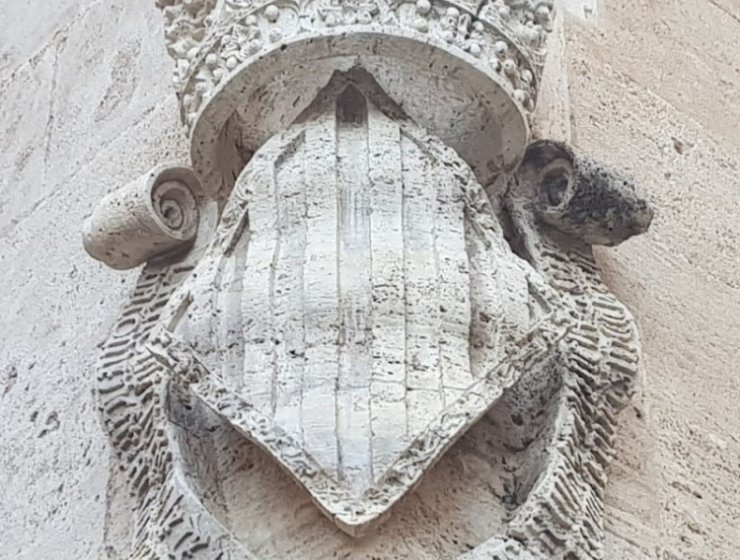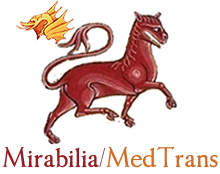
-Index-
Life and Thought, Religiosity and Conflict, Pleasure and Crime on Both Sides of the Mediterranean (the Crown of Aragon and Acre)
Antonio CORTIJO; Vicent MARTINES
Original title: Vida i pensament, religiositat i conflictivitat, relacions humanes, plaer i delicte a les dues bandes de la Mediterrània (Corona d’Aragó i Acre)
Between accounts and concerns. An approach to the material life and the thought of Valencian medieval times
Guillem Chismol
Original title: Entre comptes i cabòries. Una aproximació a la vida material i al pensament baix medieval valencià
Other works and other workers: scrap metal dealers in medieval València
MIquel FAUS FAUS
Original title: Altres treballs i altres treballadors: els ferrovellers en la València medieval
When we study the material culture of any time, special attention is paid to the different lives that an object has from its manufacture to its recycling. Through series of documents from different records, we will try to analyse the work of one of the professionals of the second-hand market: the scrap metal dealer. In the same way, we will try to understand the social image of a group that was frequently close to marginality.
The Valencian saltworks in the bases of the Early Modern
Josep Miquel CONCA
Original title: Les salines valencianes als albors de l’època moderna
The Crown established a firm monopoly on salt in kingdom of València, a system that had at its base a series of saltworks that were to supply the entire kingdom. In this article, focused in reign of Ferdinand II the Catholic, I’ll analyse the disappearance of private saltworks, the structure and the improvement of the royal saltworks and the work they provided to the inhabitants of the kingdom.
The analysis of the “other”: the Saracens in the city of Valencia in the second half of the XV century
Alejandro MORENO GIRONÉS
Original title: El análisis del “otro”: los sarracenos en la ciudad de Valencia en la segunda mitad del siglo XV
This article aims to address the vision and perception that a specific type of vassals is generated: the Saracens. The fact that we will take as a reference to be able to carry out our objective will be the assault on the Moorish quarter of Valencia in 1455. The documentation generated after this fact will allow us to analyse each of the social classes involved to be able to approach the construction of the “other”.
In fine: the last day of the livings in medieval Valencia (1390-1437)
Luis GALAN CAMPOS
Original title: In fine: el último día de los vivos en la Valencia medieval (1390-1437)
In this paper we analyse the conceptions about death and the rituals that mark the end of life in the society of the Late Middle Ages, especially among the nobility and high bourgeoisie, which are the group in that we can best ascertain these practices, taking the example of the city of Valencia, an observation point of great trustworthiness to study the whole West; that shows us that attitudes towards death face the social, political and religious changes that took place at the end of the Middle Ages.
Religiosity and conflictivities in the Crown of Aragon (15th-18th centuries)
Àlex LLINARES PLANELLS
Original title: Religiositat i conflictivitats a la Corona d’Aragó (ss. XV-XVIII)
The homiletic triad of the XVII Valencian. Biographical notes of Gaspar Blai Arbuixech, Antoni Bonaventura Guerau i Joan Baptista Ballester
Juan Miguel BLAY MARTÍ
Original title: La triada homilética del XVII valencià. Apunts biogràfics de Gaspar Blai Arbuixech, Antoni Bonaventura Guerau i Joan Baptista Ballester
The Valencian sermonist acquired an unquestionable power in the 17th century. An example of this is found in the figures of Arbuixech, Ballester and Guerau, in them we find protagonists with their own name in the religious field and local preaching preaching. In fact, they were the most remarkable personalities of the homilética genre that arose in Valencia in the middle of the six hundred that, along with other intellectuals, shaped a genuine cultural circle. Indeed, together they would integrate the triada of the native sacred oratory of the Baroque one by antonomasia. The three would be linked to the Congregation of the Oratory of Sant Felip Neri of the capital of Turia, to the immaculist cause and the devotion to San Vicente Ferrer. The historiography, however, has ignored our protagonists. There is no monographic study dedicated to them, beyond the biographical reviews of V. Ximeno or J. Rodríguez. Certainly, we have found them as part of essays devoted to classmates or preachers, already in works on preaching in the Baroque or in volumes about the University of Valencia, Valencian philology or literature. In addition, his work has reached us very unevenly. With the following lines, for all this, we will try to deduct them in value. Serve this article as a prologue to a larger work on them.
The baix Maresme in 1772 through the pastoral visit of Bishop Josep Climent
Héctor LÓPEZ SILVA
Original title: El baix Maresme l’any 1772 a través de la visita pastoral del bisbe Josep Climent
Through the realization of the pastoral visits, the bishop of the diocese could control the parishes that he had in charge. As a result of these visits a report was written in which we can find information about the structural state of the parishes that were visited, as well as the existence of chapels, beneficums, and private oratories within the parish; but these reports also inform us about the moral estate of the parish. The pastoral visit carried out by bishop Josep Climent allows us to see the changes that were happening at baix Maresme at the end of the eighteen century, such as the appearance of new towns, but also the reformist attitude that bishop Climent had, which can be seen through the decrees.
Crime and punishment: criminality in medieval Valencia in fifteenth century
Alberto BARBER BLASCO
Original title: Crim i càstig: la criminalitat a la València medieval al segle XV
Violence and justice has been present during the history at most of societies. During the Middle Age exists different behaviours that alter the order and social peace, and to face up to it, the municipal government were activated different legal mechanisms to reply that transgressive attitudes. Our criminality study in Valencia during the XV century allow us to exemplify the most habitual criminal cases that medieval justices condemn in form of punishment: economic, physical or both. The frequency with which Valencia’s city habitants report the different violent abuses allows us to know which crime and felonies were produced with more periodicity in the kingdom’s capital. In this article we will show the crime which were produced in the city of Valencia and which methods were used to eradicate these behaviours.
Introduction to the conflict between the tailors and the pellers in modern foral Valencia
Naomi BOIGUES ESCRIVÀ
Original title: Introducció a les conflictivitats gremials entre sastres i pellers en la València foral moderna
We are in the modern Valencia of the 16th century where the powers to achieve the trade union control encouraged the tensions between the closest professional groups, which had the objective of gaining ground within the complex world of craftsmanship. There are many guilds that confronted each other, but however, the tailors and pellers lawsuits have been considered as one of the most important processes and the longest historical route of trade-union unrest in the city of Valencia. The processes arranged chronologically from 1535 to 1695 will be key to understanding the reasons for the conflict, the arguments used by each guild and how they acted in this regard, to analyze who were the most affected and explain the solutions. This analysis will allow us to understand tailors and pellers trade in more detail, to realize the main characteristics of each guild and discern the historical evolution of each one of them in a closer way. A first study, which helps us to understand the importance of guild conflicts between these two trades and helps us to look beyond disobedience.
Pilgrimage Processions, Religious Sensibilities and Piety in the City of Acre in the Latin Kingdom of Jerusalem
Shlomo LOTAN
After the fall of Jerusalem in 1187, Acre became the formal capital of the Crusader Kingdom. During the 13th century, it became a pilgrimage site for many Christian pilgrims, who enriched the city with their religious ceremonies. Such as a procession called the Pardon d'Acre, which contributed greatly to our understanding of the religious places and military compounds in Frankish Acre. In this essay, I link the religious ceremonies that took place in Acre with the passages among the locations mentioned therein. All these contributed to the revival of the historical and religious space in medieval Acre.
The marriage of Bernat Català de Valleriola: from prison to legitimacy
Carles FENOLLOSA
Original title: El matrimoni de Bernat Català de Valleriola: de la presó a la legitimitat
This paper provides a general view of the process involving the marriage of Bernat Català de Valleriola (1568-1607) with Constança Rabassa de Perellós, against the will of his father-in-law Gener Rabassa de Perellós. The process was reflected not only by Valleriola’s diary but also by subsequent lawsuits.
Literature as an Instrument of Legal Defense
María DE HOCES LOMBA
Original title: La Literatura como instrumento de defensa jurídica
Based on prestigious literary works and the academic training and personal experiences of its authors, it is possible to establish a real and useful relationship between Law and Literature, so the former is capable of influencing Literature beyond mere fiction. These works, which we would call literary defenses would be able to achieve full effects in the real world, directly affecting the lives of their creators, thus fulfilling the intention with which they were written. They could be considered a subgenre on their own, because this insertion of Law in Literature originates a literary work in depth and form, being capable, at the same time, of displaying effects like a legal document.
Pleasure, sin, crime. Sexuality and sexual violence on the southern Valencian border at the end of the Middle Ages. Some examples
José Vicente CABEZUELO PLIEGO
Original title: Placer, pecado, delito. Sexualidad y violencia sexual en la frontera meridional valenciana a fines de la Edad Media. Algunos ejemplos
This study analyzes some examples extracted from archival sources to contextualize and understand the key to these type of relations in the everyday life of the southern frontier of the Kingdom of Valencia within the Crown of Aragon. It pays particular attention to some aspects of sexuality and sexual violence, the connotations and varied meaning of pleasure, sin and crime.


















































































